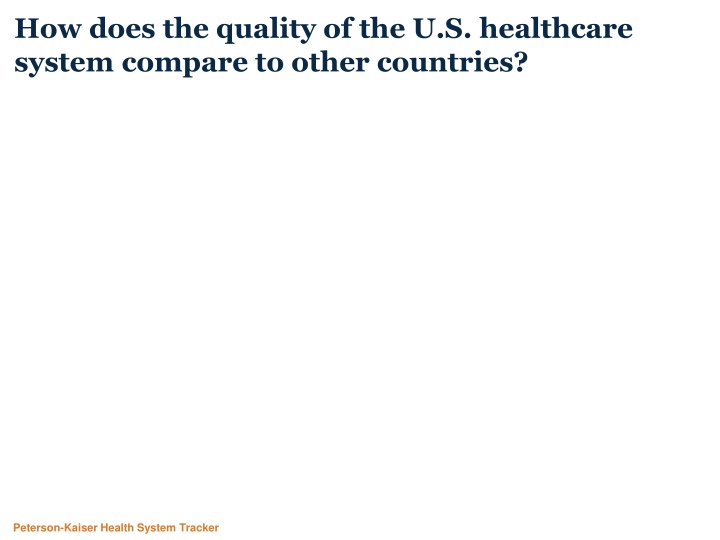
Comparison of U.S. Healthcare Quality with Other Countries
"Explore how the quality of the U.S. healthcare system compares to other countries based on mortality rates, amenable deaths, potential years of life lost, and disease burden. Data reveals areas where the U.S. healthcare system lags behind comparable OECD nations."
Download Presentation

Please find below an Image/Link to download the presentation.
The content on the website is provided AS IS for your information and personal use only. It may not be sold, licensed, or shared on other websites without obtaining consent from the author. If you encounter any issues during the download, it is possible that the publisher has removed the file from their server.
You are allowed to download the files provided on this website for personal or commercial use, subject to the condition that they are used lawfully. All files are the property of their respective owners.
The content on the website is provided AS IS for your information and personal use only. It may not be sold, licensed, or shared on other websites without obtaining consent from the author.
E N D
Presentation Transcript
How does the quality of the U.S. healthcare system compare to other countries? Peterson-Kaiser Health System Tracker
Mortality rates have fallen steadily in the U.S. and in comparable OECD countries Overall age-adjusted mortality rate per 100,000 population 1400 1223 1200 1184 1000 835 United States 800 740 Comparable country average 600 400 200 0 1980 1985 1990 1995 2000 2005 2010 Source: OECD (2013), "OECD Health Data: Health status: Health status indicators", OECD Health Statistics (database). doi: 10.1787/data-00349-en (Accessed on September 9, 2015). Notes: Break in series in 1987 and 1997 for Switzerland; in 1995 for Switzerland; in 1996 for Netherlands; in 1998 for Australia, Belgium, and Germany; in 1999 for United States; in 2000 for Canada and France; and in 2001 in the United Kingdom. All breaks in series coincide with changes in ICD coding. Peterson-Kaiser Health System Tracker
The U.S. has the highest rate of deaths amenable to health care among comparable OECD countries Amenable mortality per 100,000 population, in years, 2002 - 2003 and 2006 - 2007 2002-2003 2006-2007 120 110 103 96 100 90 84 83 81 82 82 76 80 71 70 71 67 66 65 61 61 57 56 60 40 20 0 Comparable Country Average United States France Australia Japan Sweden Netherlands Austria Germany United Kingdom Source: Nolte E, McKee C. Martin. Health Affairs Measuring the Health of Nations: Updating an Earlier Analysis Available at: http://content.healthaffairs.org/content/27/1/58.long Peterson-Kaiser Health System Tracker
Potential Years of Life Lost have fallen steadily in the U.S. and in comparable countries Overall age-specific potential years of life lost per 100,000 population 8000 7345 7000 5953 6000 4629 5000 United States 4000 2982 3000 Comparable country average 2000 1000 0 1980 1985 1990 1995 2000 2005 2010 Source: OECD (2013), "OECD Health Data: Health status: Health status indicators", OECD Health Statistics (database). doi: 10.1787/data-00349-en (Accessed on November 6, 2014). Notes: Break in series in 1987 and 1997 for Switzerland; in 1995 for Switzerland; in 1996 for Netherlands; in 1998 for Australia, Belgium, and Germany; in 1999 for United States; in 2000 for Canada and France; and in 2001 in the United Kingdom. All breaks in series coincide with changes in ICD coding. Peterson-Kaiser Health System Tracker
Disease burden is higher in the U.S. than in comparable countries Age standardized disability adjusted life year (DALY) rate per 100,000 population, 2012 United States 21,956 United Kingdom 20,384 Belgium 20,314 France 19,860 Austria 19,782 Germany 19,527 Netherlands 19,480 Canada 19,392 Comparable Country Average 19,071 Australia 18,701 Sweden 18,546 Switzerland 17,877 Japan 15,922 - 5,000 10,000 15,000 20,000 25,000 Source: Institute for Health Metrics and Evaluation. Global Burden of Disease Study 2010 (GBD 2010) Data Downloads, available here: http://ghdx.healthdata.org/global-burden-disease-study-2010-gbd-2010-data-downloads Peterson-Kaiser Health System Tracker
Hospital admissions for preventable diseases are more frequent in the U.S. than in comparable countries Age standardized hospital admission rate per 100,000 population, for asthma, congestive heart failure, uncontrolled diabetes, and diabetes short term complications, ages 15 and older, in years, 2010 United States Comparable Country Average 450 400 381 350 300 250 216 200 150 117 100 69 65 40 50 19 18 0 Congestive Heart Failure Asthma Uncontrolled Diabetes Diabetes Complications Source: OECD (2013), "OECD Health Data: Health status: Health quality indicators", OECD Health Statistics (database). doi: 10.1787/data-00349-en (Accessed on March 2, 2015). Peterson-Kaiser Health System Tracker
Foot and leg amputations due to diabetes are decreasing in the U.S. and comparable countries Age standardized diabetes lower extremity amputation rate per 100,000 population, ages 15 and older, in years 2006, 2008, and 2010 United States Comparable Country Average 40 37.5 34.5 35 30 25 20 17.1 14.7 15 8.5 10 7.4 5 0 2006 2008 2010 Source: OECD (2013), "OECD Health Data: Health status: Health quality indicators", OECD Health Statistics (database). doi: 10.1787/data-00349-en (Accessed on March 2, 2015). Notes: Data for 2006 Comparable Country Average are from 2007. Peterson-Kaiser Health System Tracker
30-day mortality for heart attacks and ischemic stroke are lower in the U.S. than in comparable countries Admission-based age standardized 30 day in-hospital mortality rate per 100 hospital discharges for acute myocardial infarction, ischemic stroke, and hemorrhagic stroke, ages 45 and older, in years, 2010 United States Comparable Country Average 25 22.3 20.9 20 15 10 8.3 6.8 5.5 4.3 5 0 Heart attack (AMI) Ischemic stroke (blood clots) Hemorrhagic stroke (bleeds) Source: OECD (2013), "OECD Health Data: Health status: Health quality indicators", OECD Health Statistics (database). doi: 10.1787/data-00349-en (Accessed on March 2, 2015). Peterson-Kaiser Health System Tracker
The U.S. has higher rates of medical, medication, and lab errors than comparable countries Medical, medication, or lab errors or delays in past two years, 2011 United States 22% Canada 21% Netherlands 20% Sweden 20% Australia 19% Comparable Country Average 16% Germany 16% France 13% Switzerland 9% United Kingdom 8% 0% 5% 10% 15% 20% 25% Note: Experienced medical mistake, given wrong medication or dose, lab test error, or delay receiving abnormal test results. Source: 2011 Commonwealth Fund International Health Policy Survey in Eleven Countries, available here: http://www.commonwealthfund.org/interactives-and-data/international- survey-data Peterson-Kaiser Health System Tracker
Post-op clots are worse in the U.S. than in comparable countries, but sepsis and suture ruptures are similar Crude rate per 100,000 hospital discharges for post-operative pulmonary embolism or deep vein thrombosis, sepsis, and wound dehiscence, ages 15 and older, in years, 2010 United States Comparable Country Average 1200 1013 1000 945 940 800 746 600 400 200 147 134 0 Post-Op Pulmonary Embolism or DVT Post-Op Sepsis Post-Op Wound Dehiscence Source: OECD (2013), "OECD Health Data: Health status: Health quality indicators", OECD Health Statistics (database). doi: 10.1787/data-00349-en (Accessed on March 2, 2015). Notes: Data for Comparable Country Average for Post-Op Pulmonary Embolism or Deep Vein Thrombosis (DVT) as well as Post-Op Sepsis are from 2011. Peterson-Kaiser Health System Tracker
There are more retained surgical items in the U.S. than across comparable countries Retained surgical item or un-retrieved device fragment crude rate per 100,000 hospital discharges, ages 15 and older, in years 2006, 2008, and 2010 United States Comparable Country Average 9 8.1 8.1 8 7.0 7 6.3 5.8 6 5.3 5 4 3 2 1 0 2006 2008 2010 Source: OECD (2013), "OECD Health Data: Health status: Health quality indicators", OECD Health Statistics (database). doi: 10.1787/data-00349-en (Accessed on March 2, 2015). Notes: Data for 2006, 2008, and 2010 Comparable Country Average are from 2007, 2009, and 2011 respectively Peterson-Kaiser Health System Tracker
Obstetric trauma during vaginal delivery is more common in the U.S. than across comparable countries Obstetric trauma during vaginal delivery with an instrument crude rate per 100 vaginal deliveries, ages 15 and older, in years 2008 and 2010 United States Comparable Country Average 14 12.5 12 11.1 10 8 6.8 6.7 6 4 2 0 2008 2010 Source: OECD (2013), "OECD Health Data: Health status: Health quality indicators", OECD Health Statistics (database). doi: 10.1787/data-00349-en (Accessed on March 2, 2015). Notes: Data for 2008 and 2010 Comparable Country Average are from 2007 and 2009 respectively. Peterson-Kaiser Health System Tracker
Five-year survival rates for certain cancers are higher in the U.S. than in comparable countries Percentage of age-adjusted five-year relative survival for breast, colorectal, and cervical cancer, ages 15-99, in years 2004-2009 United States Comparable Country Average 100 88.7 90 84.2 80 70 64.8 64.7 62.2 61.6 60 50 40 30 20 10 0 Breast Cancer Colorectal Cancer Cervical Cancer Source: OECD (2013), "OECD Health Data: Health status: Health quality indicators", OECD Health Statistics (database). doi: 10.1787/data-00349-en (Accessed on March 2, 2015). Notes: Data for breast and cervical cancers are for females. Peterson-Kaiser Health System Tracker
Mortality rates for breast and colorectal cancer in the U.S. are lower than in comparable countries Age-standardized mortality rate per 100,000 population for breast, colorectal, and cervical cancer, in years, (2010) United States Comparable Country Average 30 26.1 24.5 25 22.7 20 17.6 15 10 5 2.4 2.4 0 Breast Cancer Colorectal Cancer Cervical Cancer Source : OECD (2013), "OECD Health Data: Health status: Health status indicators", OECD Health Statistics (database). doi: 10.1787/data-00349-en (Accessed on May 5, 2015). Notes: Data for breast and cervical cancers are for females. Peterson-Kaiser Health System Tracker
The mortality rate for cancers has been falling in the U.S. and across comparable countries Age-adjusted neoplasms mortality rate per 100,000 population 300 262 250 242 Comparable country average 212 203 200 United States 150 100 50 0 1980 1985 1990 1995 2000 2005 2010 Source: OECD (2013), "OECD Health Data: Health status: Health status indicators", OECD Health Statistics (database). doi: 10.1787/data-00349-en (Accessed on November 6, 2014). Notes: Break in series in 1987 and 1997 for Switzerland; in 1995 for Switzerland; in 1996 for Netherlands; in 1998 for Australia, Belgium, and Germany; in 1999 for United States; in 2000 for Canada and France; and in 2001 in the United Kingdom. All breaks in series coincide with changes in ICD coding. Peterson-Kaiser Health System Tracker
Mortality rates for diseases of the circulatory system have fallen dramatically over the last 30 years Age-adjusted diseases of the circulatory system mortality rate per 100,000 population 700 629 600 607 500 400 300 265 United States Comparable country average 243 200 100 0 1980 1985 1990 1995 2000 2005 2010 Source: OECD (2013), "OECD Health Data: Health status: Health status indicators", OECD Health Statistics (database). doi: 10.1787/data-00349-en (Accessed on November 6, 2014). Notes: Break in series in 1987 and 1997 for Switzerland; in 1995 for Switzerland; in 1996 for Netherlands; in 1998 for Australia, Belgium, and Germany; in 1999 for United States; in 2000 for Canada and France; and in 2001 in the United Kingdom. All breaks in series coincide with changes in ICD coding. Switzerland does not provide data for acute myocardial infarction. Peterson-Kaiser Health System Tracker
The mortality rate for respiratory diseases is higher in the U.S. than in comparably wealthy countries Age-adjusted respiratory diseases mortality rate per 100,000 population 120 100 93 82 80 80 United States 63 Comparable country average 60 40 20 0 1980 1985 1990 1995 2000 2005 2010 Source: OECD (2013), "OECD Health Data: Health status: Health status indicators", OECD Health Statistics (database). doi: 10.1787/data-00349-en (Accessed on November 6, 2014). Notes: Break in series in 1987 and 1997 for Switzerland; in 1995 for Switzerland; in 1996 for Netherlands; in 1998 for Australia, Belgium, and Germany; in 1999 for United States; in 2000 for Canada and France; and in 2001 in the United Kingdom. All breaks in series coincide with changes in ICD coding. Peterson-Kaiser Health System Tracker
Mortality rates for endocrine, nutritional and metabolic diseases have fallen over the last 15 years Age-adjusted endocrine, nutritional and metabolic diseases mortality rate per 100,000 population 60 50 40 34 United States 28 30 Comparable country average 23 23 20 10 0 1980 1985 1990 1995 2000 2005 2010 Source: OECD (2013), "OECD Health Data: Health status: Health status indicators", OECD Health Statistics (database). doi: 10.1787/data-00349-en (Accessed on November 6, 2014). Notes: Break in series in 1987 and 1997 for Switzerland; in 1995 for Switzerland; in 1996 for Netherlands; in 1998 for Australia, Belgium, and Germany; in 1999 for United States; in 2000 for Canada and France; and in 2001 in the United Kingdom. All breaks in series coincide with changes in ICD coding. Peterson-Kaiser Health System Tracker
Use of the emergency department in place of regular doctor visits is more common in the U.S. than in most comparable countries Percent that used Emergency Department for a condition that could have been treated by a regular doctor or place of care in the past 2 years, ages 65 and older, 2014 Canada 15% United States 13% Sweden 10% Switzerland 8% Comparable Country Average 7% Australia 7% Netherlands 6% United Kingdom 4% France 4% Germany 3% 0% 2% 4% 6% 8% 10% 12% 14% 16% Source: 2014 Commonwealth Fund International Health Policy Survey in Eleven Countries, available here: http://www.commonwealthfund.org/interactives-and-data/international-survey-data Peterson-Kaiser Health System Tracker
Adults in most comparable countries have quicker access to a doctor or nurse when they need care Percent that made a same-day or next day appointment or waited six days or more days for an appointment when sick or needed care, ages 18 and older, 2013 Waited six days or more for appointment Same-day or next-day appointment 33% Canada 41% 26% United States 48% 16% United Kingdom 52% 16% France 57% 22% Sweden 58% 19% Comparable Country Average 58% 14% Australia 58% 14% Netherlands 63% 15% Germany 76% 0% 10% 20% 30% 40% 50% 60% 70% 80% Source: 2013 Commonwealth Fund International Health Policy Survey in Eleven Countries, available here: http://www.commonwealthfund.org/interactives-and-data/international-survey-data Peterson-Kaiser Health System Tracker
Use of the emergency department in place of regular doctor visits is more common in the U.S. than in most comparable countries Percent that used Emergency Department for a condition that could have been treated by a regular doctor or place of care in the past 2 years, ages 65 and older, 2014 Canada 15% United States 13% Sweden 10% Switzerland 8% Comparable Country Average 7% Australia 7% Netherlands 6% United Kingdom 4% France 4% Germany 3% 0% 2% 4% 6% 8% 10% 12% 14% 16% Source: 2014 Commonwealth Fund International Health Policy Survey in Eleven Countries, available here: http://www.commonwealthfund.org/interactives-and-data/international-survey-data Peterson-Kaiser Health System Tracker






















